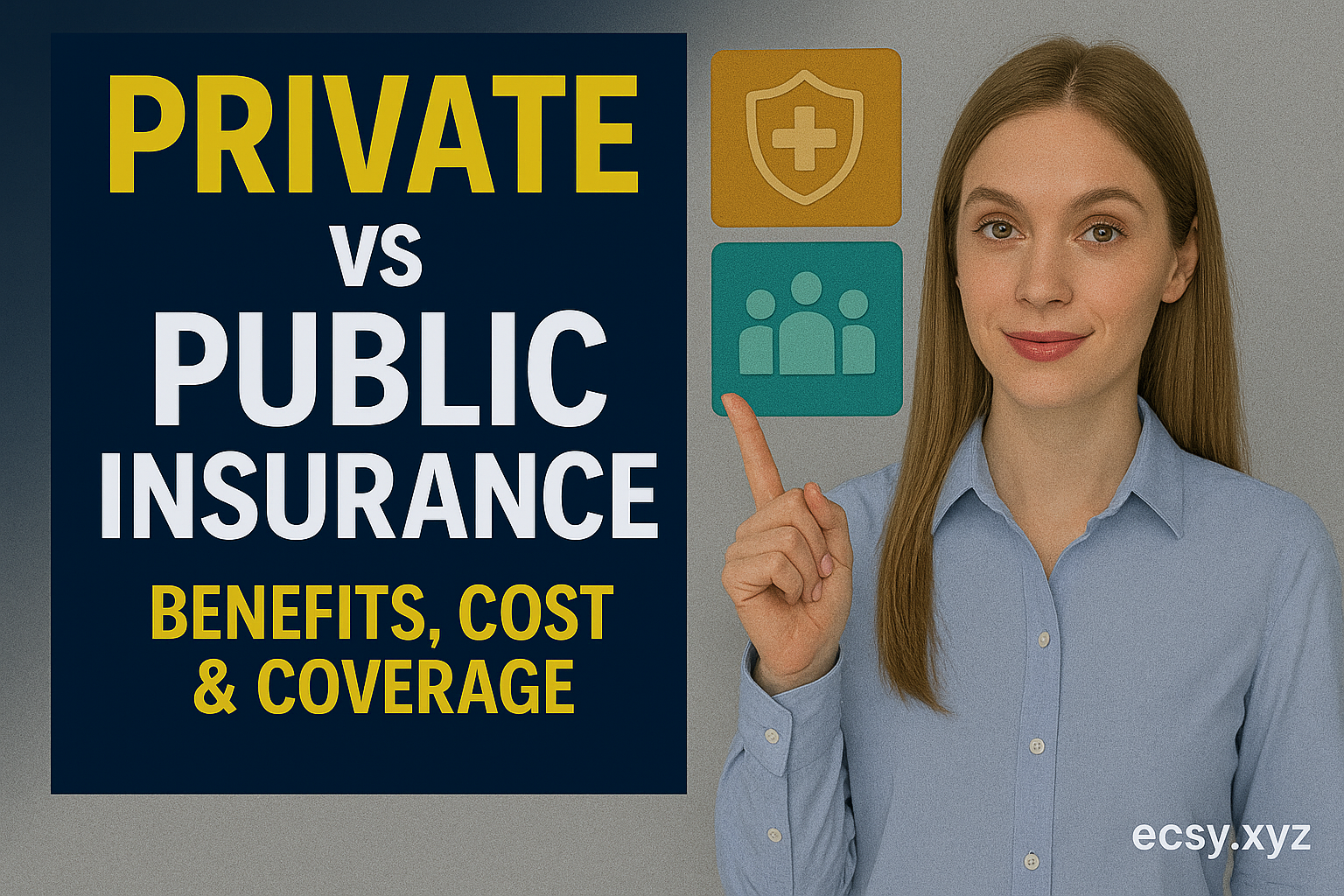Private vs Public Health Insurance: Navigating the world of health insurance can feel like trying to read ancient Greek—confusing, frustrating, and loaded with hidden meanings. Whether you’re new to the topic or just trying to figure out if you should switch plans, understanding the differences between public and private health insurance is a must.
This guide breaks it down in plain English—no jargon, just facts, comparisons, pros, cons, and everything in between.
What is Public Health Insurance?
Public health insurance is a government-funded healthcare system that aims to provide access to medical services for all citizens or eligible residents.
Key Features:
-
Funded through taxes
-
Universally available in many countries
-
Typically covers basic healthcare needs
Examples:
-
United Kingdom – The NHS offers free-at-point-of-service care to UK residents.
-
Canada – The public healthcare system covers most medical services.
-
United States – Medicaid and Medicare are public insurance programs for low-income individuals and seniors.

What is Private Health Insurance?
Private health insurance is provided by non-governmental companies. You pay a premium in exchange for coverage of healthcare services, often with more flexibility and speed.
Key Features:
-
Optional (unless required by law)
-
Can be purchased individually or through employers
-
Offers access to private hospitals and specialists
Examples:
-
Blue Cross Blue Shield (USA)
-
Bupa (UK & Australia)
-
Cigna, Aetna, UnitedHealthcare
Key Differences Between Public and Private Health Insurance
Ownership and Funding
-
Public: Government-funded via taxes.
-
Private: Paid by individuals or employers through premiums.
Accessibility and Eligibility
-
Public: Often universally available or based on income.
-
Private: Depends on age, health, income, and application approval.
Cost and Premiums
-
Public: Generally free or low-cost at the point of care.
-
Private: Can be expensive, especially without employer contributions.
Waiting Times
-
Public: Longer queues for elective procedures.
-
Private: Faster access to diagnostics and treatment.
Freedom of Choice
-
Public: Limited provider options.
-
Private: Broader selection of doctors and facilities.
Types of Coverage
-
Public: Basic care, emergencies, general practitioners.
-
Private: Dental, vision, cosmetic surgeries, alternative therapies.
Benefits of Public Health Insurance
Universal Access
Everyone, regardless of income or employment, has access to basic care.
Lower Costs
Public systems negotiate prices and reduce administrative costs.
Government Oversight
Strict regulations reduce fraud and ensure safety.
Drawbacks of Public Health Insurance
Long Waiting Periods
Need a knee surgery? You might be waiting months.
Limited Options
Public systems usually don’t cover dental, vision, or elective treatments.
Bureaucratic Red Tape
Paperwork and referral systems can slow things down.
Benefits of Private Health Insurance
Quick Appointments
You’re seen faster—sometimes within days.
Wider Choice of Providers
Pick your own specialist, hospital, or clinic.
Customizable Coverage
Choose what matters to you—maternity, dental, rehab, mental health.
Drawbacks of Private Health Insurance
Higher Costs
Premiums, copays, deductibles—it adds up fast.
Policy Exclusions
Not all plans cover pre-existing conditions, mental health, or maternity.
Denials & Loopholes
Ever read fine print in a 50-page policy? Yeah, it’s there for a reason.
Cost Comparison
| Aspect | Public Insurance | Private Insurance |
|---|---|---|
| Monthly Premium | Usually free or subsidized | Varies; often high |
| Deductibles | Low or none | Medium to high |
| Copays | Minimal or none | Moderate to high |
| Hidden Costs | Rare | Common (e.g. limits, exclusions) |
Private insurance may cost more upfront, but offers more flexibility and faster access. Public insurance is cheaper, but comes with waitlists and limitations.
Coverage Comparison
| Service | Public Insurance | Private Insurance |
|---|---|---|
| Emergency Services | ✅ Yes | ✅ Yes |
| Specialist Consultations | ✅ Yes (with wait) | ✅ Yes (faster) |
| Elective Surgeries | 🚫 Limited | ✅ Yes |
| Mental Health | ✅ Basic coverage | ✅ Broader options |
| Dental/Vision | 🚫 Not Included | ✅ Included (with plan) |
Which One is Better for You?
It depends. Ask yourself:
-
Do I have ongoing medical conditions?
-
Is budget a concern?
-
Do I want provider flexibility?
-
Can I wait for treatment?
If you’re young and healthy, public insurance might be enough. If you have specific needs, private insurance may be worth the cost.
Can You Combine Both?
Absolutely. Many people do!
Hybrid Models:
-
Use public insurance for basic services
-
Add private insurance for faster access or extras like dental/vision
-
Common in countries like Germany and Australia
Future of Health Insurance
Health insurance is evolving fast with:
-
Telemedicine
-
AI-based diagnostics
-
Flexible micro-insurance packages
-
More public-private partnerships
Staying informed is key to choosing what works for your life.
Conclusion
Choosing between public and private health insurance isn’t black and white. It’s about what fits your needs, lifestyle, and budget. Public insurance offers affordability and basic access, while private plans promise speed and choice. Want the best of both worlds? A combo plan might be your sweet spot.
Your health is personal—your insurance should be too.
FAQs
1. Can I switch from public to private health insurance?
Yes, though it depends on your country and eligibility. Some systems allow opt-outs; others don’t.
2. Does private health insurance cover everything?
Not always. Most plans have exclusions and limits. Always read the fine print.
3. Why is public healthcare cheaper?
Because it’s funded by taxpayers and designed for efficiency, not profit.
4. Is private insurance worth it if I’m healthy?
Maybe not now, but it might save you time and money during unexpected health events.
5. Can I have both types of insurance at once?
Yes! Many people combine them to cover gaps and gain faster access.

